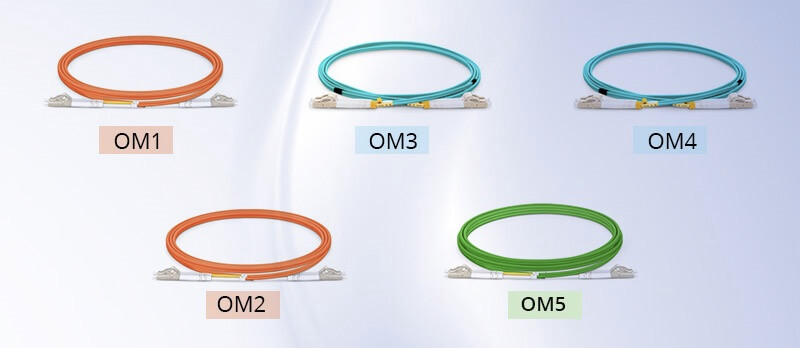Several types of multimode fiber are available for high-speed network installations, each offering different reach and data-rate capabilities. Choosing the right multimode fiber for your network can be challenging with options like OM1, OM2, OM3, OM4, and OM5. This article will provide insights into the differences between them and help you make an informed decision.
What Is Multimode Fiber?
Multimode fiber (MMF) is a type of optical fiber commonly used for short-distance communication, such as within buildings or campuses. It features a larger core, typically 50 or 62.5 microns, which allows multiple light modes to be transmitted simultaneously. This characteristic enables higher data throughput in the fiber core. MMF cables can transmit up to approximately 550 meters at a speed of 10 Gbit/s. At lower data rates, such as 100 Mb/s, MMF can achieve longer transmission distances, reaching around 2 kilometers.
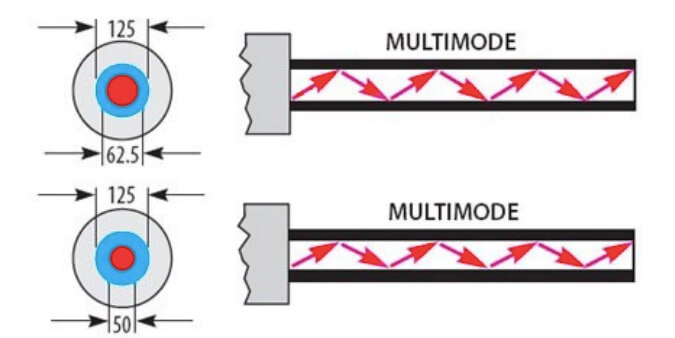
How Many Types of Multimode Fiber?
There are five types of multimode fiber optic cables, classified according to the ISO 11801 standard: OM1 fiber, OM2 fiber, OM3 fiber, OM4 fiber, and OM5 fiber. In the following section, we will compare these fibers based on core size, bandwidth, data rate, transmission distance, color, and optical source in detail.
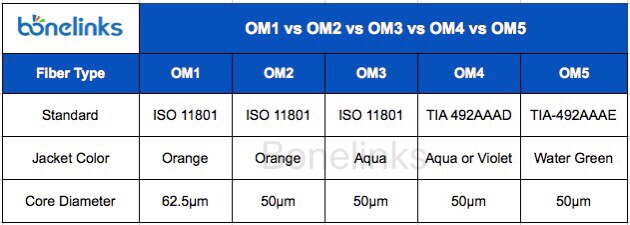
OM1 Fiber
OM1 fiber is identifiable by its orange jacket and features a core size of 62.5 µm. It is capable of supporting 10 Gigabit Ethernet with transmission distances of up to 33 meters. OM1 fiber is primarily employed for 100 Megabit Ethernet applications and typically utilizes a LED light source.
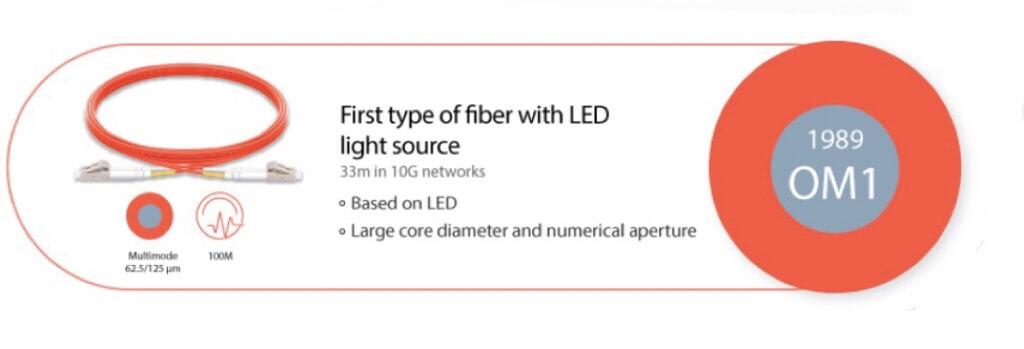
OM2 Fiber
Similarly, OM2 fiber is distinguishable by its orange jacket and employs a LED light source, featuring a core size of 50 µm. It can facilitate up to 10 Gigabit Ethernet with transmission distances of up to 82 meters. However, OM2 fiber is more commonly utilized for 1 Gigabit Ethernet applications.
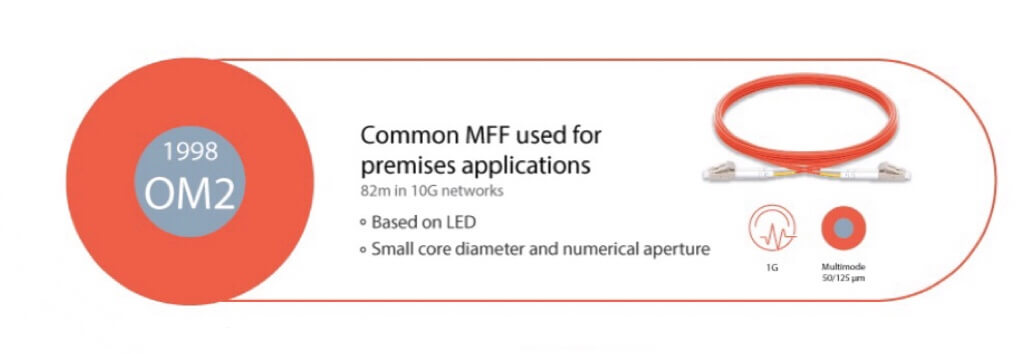
OM3 Fiber
OM3 fiber is easily recognizable due to its aqua-colored jacket. It shares the same core size of 50 µm as OM2 fiber, but it is optimized for laser-based equipment. OM3 fiber can accommodate 10 Gigabit Ethernet with transmission distances of up to 300 meters. Moreover, OM3 fiber is capable of supporting 40 Gigabit and 100 Gigabit Ethernet up to 100 meters, although 10 Gigabit Ethernet remains its most common application.
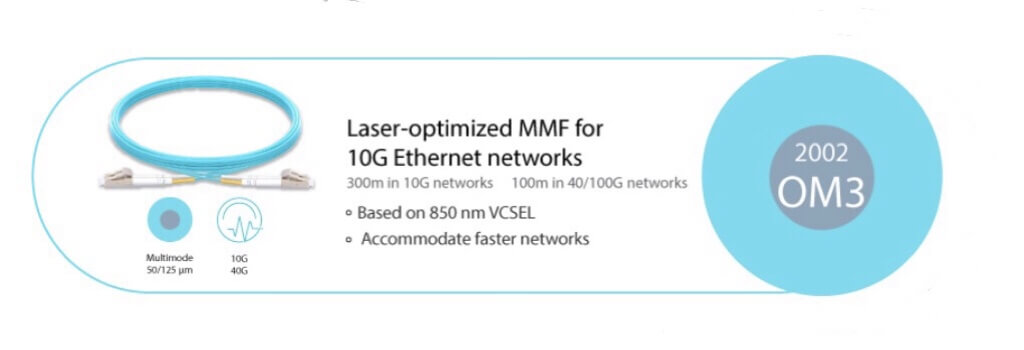
OM4 Fiber
OM4 fiber maintains complete backward compatibility with OM3 fiber. It has an aqua-colored or violet color jacket. Developed with a focus on VSCEL laser transmission, OM4 fiber enhances performance compared to OM3. It extends 10 Gigabit Ethernet link distances to up to 550 meters, a notable improvement from OM3’s 300 meters. Additionally, OM4 fiber supports 40/100 Gigabit Ethernet up to 150 meters using an MPO connector.

OM5 Fiber
OM5 fiber, or Wideband Multimode Fiber (WBMMF), is the latest addition to the multimode fiber lineup. It retains backward compatibility with OM4 fiber and shares the same core size as OM2, OM3, and OM4. Distinguished by its lime green jacket color, OM5 fiber is engineered to accommodate a minimum of four WDM (Wavelength Division Multiplexing) channels. These channels operate within the 850-953 nm wavelength range and support speeds of at least 28 Gbps per channel.

OM1 vs OM2 vs OM3 vs OM4 vs OM5: What’s the Difference?
Now that we’ve gained a general understanding of OM1, OM2, OM3, OM4, and OM5 multimode fibers, let’s delve into the distinctive characteristics that set them apart functionally. While their physical identification is straightforward, the functional disparities between these fiber types are of paramount importance. In this section, we will delve into the key differences in their applications and functional attributes, including bandwidth, wavelength, maximum speed, and transmission distance, among others.
Bandwidth & Optical Source
Bandwidth refers to the maximum data transfer rate over a specific path within a designated time frame. A greater bandwidth equates to a higher data capacity received per second. Each of the OM1, OM2, OM3, OM4, and OM5 fibers has its own specified minimum Modal Bandwidth (MBW) requirement. Additionally, it’s noteworthy that while OM1 and OM2 typically utilize LED light sources, OM3, OM4, and OM5 predominantly employ 850 nm VCSELs.
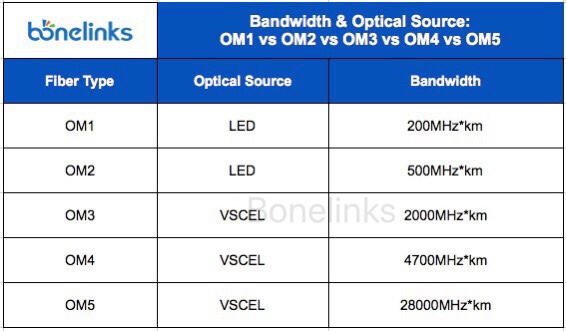
Speed
Speed, or data rate, signifies the rate at which data information is transmitted within a specific timeframe. OM1, OM2, OM3, OM4, and OM5 fibers are capable of supporting various data rates, each catering to distinct usage scenarios. The following figure outlines the most commonly employed data rate and the maximum supported speed for each type of multimode fiber.

Distance
Distance determines the extent to which OM fiber can effectively transmit data from one end to another while maintaining an acceptable range of link loss. The maximum transmission distance varies depending on the data rates involved. The figure provided below illustrates the maximum distances that OM1, OM2, OM3, OM4, and OM5 multimode fibers can achieve at specific supported speeds through multimode transceiver modules.
Please note that the maximum reach values mentioned above are based on standard transceivers such as 100BASE-FX, 1000BASE-SX, 10GBASE-SR, 25GBASE-SR, 40GBASE-SR4, and 100GBASE-SR10 over multimode fiber. When employing other transceivers, the distances may vary.
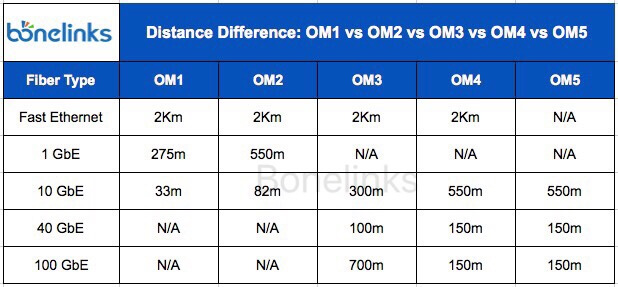
Loss Limit
In addition to distance, it’s important to consider the loss limit when deploying multimode fiber in certain applications. For instance, OM4 fiber can effectively support 100GbE up to a distance of 150m, provided that the fiber loss remains below 1.5 dB.

Application
Multimode fibers are able to transmit different distance ranges at various data rate. You can choose the most suited one according to your actual application.

Cost
OM5 represents the latest and most premium multimode fiber variant, ideal for high-speed applications that demand SWDM technology. Comparatively, OM4 is more budget-friendly and currently suitable for 40G/100G applications, covering distances up to 150m, similar to OM5. For small to medium-sized businesses (SMBs) and enterprises, opting for 10Gb OM3 multimode fiber proves to be a cost-effective choice, fulfilling existing 10GbE needs while offering future-proofing capabilities for potential 40G/100G upgrades. On the other hand, OM1 and OM2 are the most economical options but are somewhat outdated due to their limitations in transmission.
Why Choose Multimode Fiber?
- Cost Efficiency
Multimode fiber provides support for the distances commonly required in enterprise and data center networks, all at a significantly lower cost compared to single mode fiber. This cost-efficiency is a compelling factor for network deployments. - Multi-User Capability
Multimode fiber allows multiple signals to be transmitted concurrently on the same line without significant loss interference. This enables simultaneous transmission of multiple packets without compromising data integrity or causing interference. - Support for Various Protocols
Multimode fiber can accommodate a range of data transfer protocols, including Ethernet, Infiniband, and Internet protocols. This versatility makes it a versatile choice for various high-value applications. - Ease of Installation
With a larger fiber core and generous alignment tolerances, multimode fiber components are easier to handle and less expensive to install. Components like fiber connectors, adapters, and patch cords are more manageable and affordable compared to single mode fiber.
Overall, multimode fiber offers a balance between performance, cost, and ease of implementation, making it suitable for many network scenarios.
How to Choose the Right Multimode Fiber?
Here are some key points to consider:
- OM1 fiber is becoming obsolete due to fiber technology advancements. Stick with 62.5/125 µm if currently using it to avoid signal loss from mixing different core sizes. OM2, OM3, and OM4 have a 50/125 µm core size.
- OM3 is ideal for 10Gb Ethernet, designed specifically for this purpose. For longer distances and 10G/40G/100G Ethernet, opt for OM4.
- Cost is a significant factor to consider.
- Ensure compatibility with the rest of the network, including transceivers and switches, for smooth integration.
FAQs on OM1 OM2 OM3 OM4 OM5 Multimode Fiber
Q: What’s the Principle Among OM1 OM2 OM3 OM4 Compatibility?
A: Generally, it is possible to mix and connect different multimode fiber types with varying performance levels. This compatibility is feasible due to the shared core diameter. For instance, OM2, OM3, OM4, and OM5 with a 50/125 core size can be used interchangeably with other 50/125 (OM2/OM3/OM4/OM5) fibers. However, it’s important to note that when connecting higher-performance fibers with lower-performance ones, the overall performance achieved will be limited by the lower-grade fiber.
OM5 fiber is backward compatible with OM4, and OM4 is backward compatible with OM3. When connecting OM3 to OM4 fiber, the performance outcome might align more closely with that of OM3 due to compatibility considerations.
Q: Is OM1 compatible with OM3?
A: The compatibility between OM1 and OM3 multimode fibers depends on the specific use case. If you are replacing OM1 fiber with OM3 multimode fiber for data transmission, it can generally be done.
Q: Can I splice OM1 to OM3?
A: It is not recommended to splice OM1 fiber with OM3 fiber due to their different core sizes. OM1 has a core diameter of 62.5/125, while OM3 has a core diameter of 50/125. While some companies, like Corning, have experimented with mixing 62.5/125 (OM1) with 50/125 (OM2/OM3/OM4), most equipment manufacturers do not recommend using them together in a single link. Severe signal loss may occur, and while it might work on one end, it could fail on the other.
Conclusion
Multimode fiber is commonly selected for backbone applications within buildings due to its high capacity and reliability. It remains a cost-effective solution for enterprise and data center needs, particularly when transmission distances fall within the 500-600 meter range. However, it’s important to note that multimode fiber cannot completely replace single mode fiber in all scenarios. The decision between using a single mode fiber patch cord or a multimode patch cord depends on various factors, including the specific applications, required transmission distance, and available budget. Each fiber type has its advantages and limitations, so careful consideration is necessary to choose the most suitable option for a given situation.

